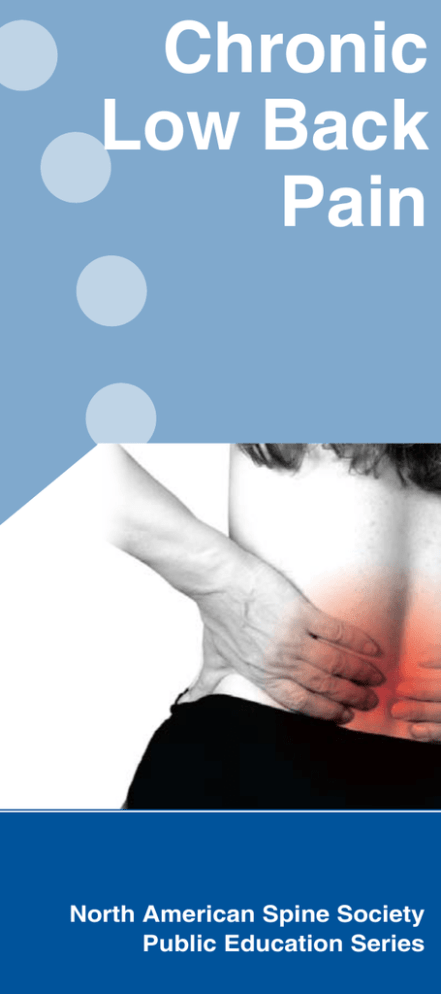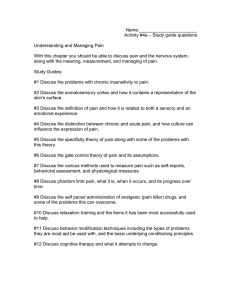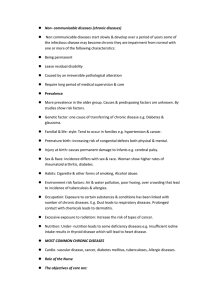Chronic Low Back Pain
advertisement

Chronic Low Back Pain North American Spine Society Public Education Series What is Chronic Pain? Low back pain is considered to be chronic if it has been present for longer than three months. Chronic low back pain may originate from an injury, disease or stresses on different structures of the body. The type of pain may vary greatly and may be felt as bone pain, nerve pain or muscle pain. The sensation of pain may also vary. For instance, pain may be aching, burning, stabbing or tingling, sharp or dull, and well-defined or vague. The intensity may range from mild to severe. Many times, the source of the pain is not known or cannot be clearly defined. In fact, in many instances, the condition or injury that triggered the pain may be completely healed and undetectable, but the pain may still continue to bother you. Even if the original cause of the pain is healed or unclear, the pain you feel is real. It is your health care provider’s job respect your experience of pain, regardless of its cause. What Causes It? Chronic low back pain may be caused by many different sources. It may start from diseases, injuries or stresses to many different structures including bones, muscles, ligaments, joints, nerves or the spinal cord. The affected structure will send a signal through nerve endings, up the spinal cord and into the brain where it registers as pain. Many different theories try to explain chronic pain. The exact mechanism is not completely understood. In general, it is believed that the nerve pathways that carry the pain signals from the nerve endings through the spinal cord and to the brain may become sensitized. Sensitization of these pathways may increase the perceived pain out of proportion to the source of the pain. Stimuli that ordinarily are not perceived as painful, such as light touch, can be amplified or changed by these sensitized pathways and experienced as pain. Sometimes, even after the original injury or disease process has healed, sensitized pathways continue to send signals to the brain. These signals feel just as real and sometimes worse than the pain caused by the original injury or disease process. Imagine an old television set or computer screen on which the same image is continuously projected. This image is eventually “burned” into the screen. Even when the screen is turned off, the image can still be seen on the screen. In the same manner, after the original source of pain is healed or no longer present, chronic pain patients may continue to feel pain. Although this is an over simplification of what may happen in chronic pain, it helps explain the basic concept. How Is Chronic Low Back Pain Diagnosed? As mentioned earlier, chronic low back pain is defined as back pain that lasts longer than three months. During the evaluation of chronic back pain, it is important to rule out any injuries or disease processes that could place you at risk for further injury if not treated or addressed. Clarification of the diagnosis is a key step in creating a pain management program. A good patient history and a thorough physical examination by a well-trained clinician are the most important aspects of the evaluation. Serious injuries and illnesses can often be diagnosed or ruled out based on the history and physical examination alone. However, lack of a definite diagnosis does not necessarily mean more testing is needed. Needless tests do not add anything to what your health care provider has already discovered in his or her physical examination. (In fact, unnecessary testing is not only expensive, but it could expose you to unnecessary risks or radiation.) If your health care provider feels that more testing is needed based on your history and physical examination findings, he or she will discuss with you the appropriate tests to be ordered. Testing may include blood tests, radiography (X-ray films), bone scans, computed tomography (CT) scans, magnetic resonance imaging (MRI), diagnostic injections, electromyography (EMG) and many other specialized tests. Many times, the exact cause of the pain is still not well defined at the end of the evaluation. Nevertheless, an evaluation is successful if it has ruled out those processes that could place you at risk if not treated. What Treatments Are Available? Treatments for chronic back pain can vary greatly depending on the type and source of the pain. If a treatable source of the pain is found, then the underlying process should be treated. When the underlying cause is either not known or not treatable, then the symptoms are treated. The goals of the treatment are to reduce pain, improve quality of life and increase function. Treatment for chronic pain includes several different general categories. These categories include physical therapy, medications, coping skills, procedures and complementary medicine treatments. Your health care provider will tailor a program involving a combination of these general options which best addresses your needs. Physical therapy includes patient education and a variety of stretching and strengthening exercises, manual therapies and modalities (ice, heat, transcutaneous electrical nerve stimulation [TENS], ultrasound, etc.) to treat pain. Active therapies which you can continue on your own, such as exercise and strengthening, usually have the most permanent and long lasting effects. Exercise and strengthening are designed to increase stability and strength around the structures in the back that are being stressed. They also work to avoid deconditioning that results from decreased activity. Exercises are tailored specifically to your abilities and the type of back pain being addressed. Treatments... Continued Medications used for treatment of pain are multiple and varied. They fall into several different categories. Both non-narcotic and, rarely, narcotic pain medications may be used in the treatment of chronic back pain. Nonsteroidal antiinflammatory drugs (NSAIDs) are helpful with pain control and may help reduce inflammation. (See the NASS Patient Education Brochure on NSAIDs for more information on their proper use.) Muscle relaxants can also help with chronic pain and may enhance the effects of other pain medications. Nerve stabilizing drugs (antidepressants and antiseizure medications) are used to treat nerve-mediated pain. All these medications have different potential side effects and interactions and should be carefully monitored by your health care professional. Coping skills are extremely important in the management of chronic back pain. Chronic pain directly affects all areas of your life. Pain affects mood, and your mood affects your ability to cope with pain. Pain also affects how you interact with other people. For this reason, learning appropriate coping skills for dealing with anxiety, depression, irritability and frustration can be invaluable. Visiting a trained pain specialist, psychologist or psychiatrist greatly enhances the treatment of chronic back pain. (See the NASS Patient Education Brochure on Back Pain and Your Emotions for more information.) Procedures ranging from minimally invasive injections to surgery may be used in chronic pain. Sometimes, implantable devices are beneficial in treating chronic pain. You should discuss the potential risks and benefits of any procedures considered with your health care provider. Often a second opinion is beneficial. Complementary medicine also provides a variety of treatments often helpful in the treatment of chronic pain. These treatments include acupuncture, dry needling, nutrition, magnets and many others. It is important for you to discuss these treatments with your health care provider. It is important to be sure that any complementary medical interventions work well with your other treatments. Make certain you fully understand any treatment option that you are given. Ask questions if something is not clear. The North American Spine Society also offers a wide range of patient education brochures on spine procedures to help you be an informed participant in your care. For More Information, Please Contact: North American Spine Society 7075 Veterans Boulevard Burr Ridge, IL 60527 Phone (866) 960-NASS (6277) Fax (630) 230-3700 Visit Us on the Internet at: www.KNOWYOURBACK.ORG DISCLAIMER This brochure is for general information and understanding only and is not intended to represent official policy of the North American Spine Society. Please consult your physician for specific information about your condition. © 2006-2009 North American Spine Society Printed on recycled paper.

